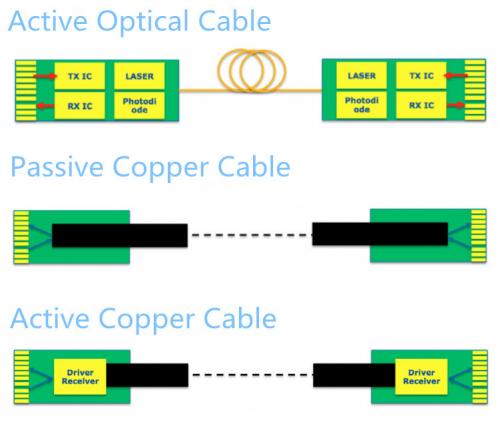The Installation/Remove Guide About The QSFP+ Transceivers and DAC/AOC Cables

It’s known that Direct Attach Copper Cable(DAC) and Active Optical Cable (AOC) are now applied in the data center widely for short-distance interconnection due to their respective unique advantages. With the respect to them, usually, we may only get that they are two kinds of optical transceiver assemblies, terminated with transceiver-style plugs used in the same ports as optical transceivers used. However, except for these, as for their other information, such as advantages or disadvantages, or differences and so on, how much do you know? Now, this article will make a detailed comparison for them to introduce them to us.
When it comes to their differences, maybe we can get about it from their designs and structures.
AOCs are active devices, incorporating active electric and optic components to transmit/receive signal via optic fiber. While DACs can be both passive and active. The passive DACs (often called PCCs) have no active circuitry, which means there is a direct connection between copper cable and optical transceiver’s printed circuit board (PCB) electrical contacts. Besides, the active DACs (often called ACCs) incorporate active component to transmit/receive signal via copper cable. The following figure shows the general internal structure of AOCs and DACs.
Due to different design and structure, naturally, they distinguish in advantages. The below is about the comparison of them.
Relatively speaking, AOC is with these strengths:
- With higher bandwidth: Device upgrading is unnecessary, on account that it has a throughput of up to 40 Gbps with QSFP+.
- EMI immunity—For the reason that the optic fibre is not able to conduct electric current, AOC is immune to electromagnetic energy.
- Light in weight: Because of its material, AOC weighs less than a comparable direct attach copper cable. Light in weight: Because of its material, AOC weighs less than a comparable direct attach copper cable.
While DAC is with those benefits:
- With interchangeability: DAC is interchangeable and hot swappable with fiber optic modules.
- With higher data rate: DAC data rate, higher than traditional copper interfaces, is available for various applications .
- Cost effective: DAC is accorded with various protocols such as gigabit & 10G Ethernet, 8G FC, FCOE and Infiniband. It’s a cost effective solution over optical transceivers.
In addition, except for the differences in advantages, they differ in disadvantages.
In size and weight, compared with the AOC, DAC is heavier and bulkier, making it difficult to be managed. While in cost, compared with DAC, the drawback of AOC may be more expensive for customers.
Above all is about the comparison between the DAC and AOC. If wanting to know more about it, welcome to contact us.
Note: We are a sub-brand of Gigalight, we focus on high-end optical network devices, mainly supplying industrial-grade optical transceivers and professional optical interconnection components for data centers. With more than 10 years' experience in optics industry, we now have professional R&D team(more than 100 engineers) and stable supply ability.
Post Your Ad Here
Comments